engine CADILLAC ESCALADE ESV 2008 Owner's Manual
[x] Cancel search | Manufacturer: CADILLAC, Model Year: 2008, Model line: ESCALADE ESV, Model: CADILLAC ESCALADE ESV 2008Pages: 500, PDF Size: 6.65 MB
Page 165 of 500
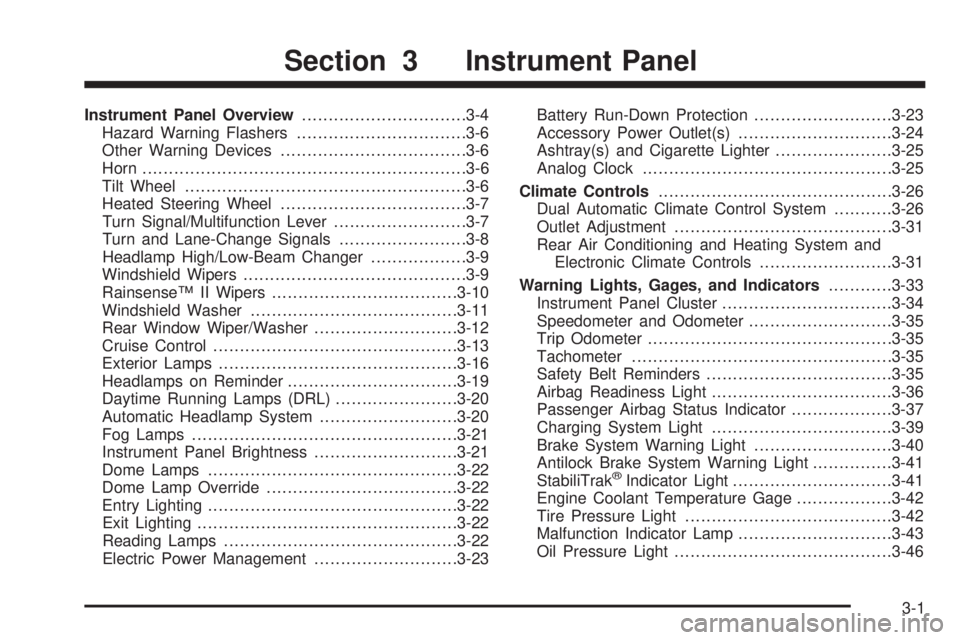
Instrument Panel Overview .............................. .3-4
Hazard Warning Flashers ............................... .3-6
Other Warning Devices .................................. .3-6
Horn ............................................................ .3-6
Tilt Wheel .................................................... .3-6
Heated Steering Wheel .................................. .3-7
Turn Signal/Multifunction Lever ........................ .3-7
Turn and Lane-Change Signals ....................... .3-8
Headlamp High/Low-Beam Changer ................. .3-9
Windshield Wipers ......................................... .3-9
Rainsense™ II Wipers .................................. .3-10
Windshield Washer ...................................... .3-11
Rear Window Wiper/Washer .......................... .3-12
Cruise Control ............................................. .3-13
Exterior Lamps ............................................ .3-16
Headlamps on Reminder ............................... .3-19
Daytime Running Lamps (DRL) ...................... .3-20
Automatic Headlamp System ......................... .3-20
Fog Lamps ................................................. .3-21
Instrument Panel Brightness .......................... .3-21
Dome Lamps .............................................. .3-22
Dome Lamp Override ................................... .3-22
Entry Lighting .............................................. .3-22
Exit Lighting ................................................ .3-22
Reading Lamps ........................................... .3-22
Electric Power Management .......................... .3-23 Battery Run-Down Protection ......................... .3-23
Accessory Power Outlet(s) ............................ .3-24
Ashtray(s) and Cigarette Lighter ..................... .3-25
Analog Clock .............................................. .3-25
Climate Controls ........................................... .3-26
Dual Automatic Climate Control System .......... .3-26
Outlet Adjustment ........................................ .3-31
Rear Air Conditioning and Heating System and
Electronic Climate Controls ........................ .3-31
Warning
Lights, Gages, and Indicators ........... .3-33
Instrument Panel Cluster ............................... .3-34
Speedometer and Odometer .......................... .3-35
Trip Odometer ............................................. .3-35
Tachometer ................................................ .3-35
Safety Belt Reminders .................................. .3-35
Airbag Readiness Light ................................. .3-36
Passenger Airbag Status Indicator .................. .3-37
Charging System Light ................................. .3-39
Brake System Warning Light ......................... .3-40
Antilock Brake System Warning Light .............. .3-41
StabiliTrak ®
Indicator Light ............................. .3-41
Engine Coolant Temperature Gage ................. .3-42
Tire Pressure Light ...................................... .3-42
Malfunction Indicator Lamp ............................ .3-43
Oil Pressure Light ........................................ .3-46Section 3 Instrument Panel
3-1
Page 187 of 500
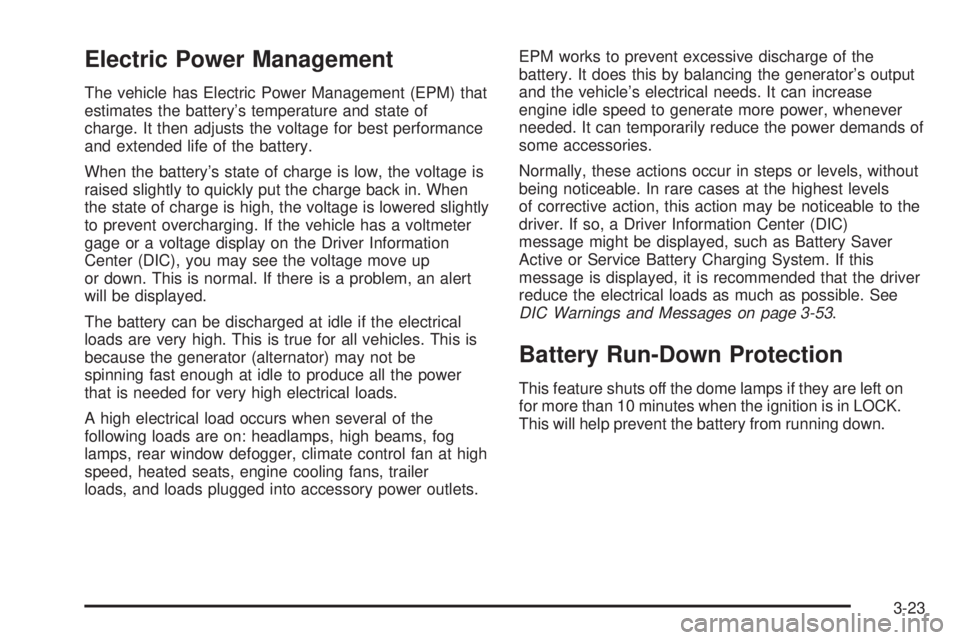
Electric Power Management The vehicle has Electric Power Management (EPM) that
estimates the battery’s temperature and state of
charge. It then adjusts the voltage for best performance
and extended life of the battery.
When the battery’s state of charge is low, the voltage is
raised slightly to quickly put the charge back in. When
the state of charge is high, the voltage is lowered slightly
to prevent overcharging. If the vehicle has a voltmeter
gage or a voltage display on the Driver Information
Center (DIC), you may see the voltage move up
or down. This is normal. If there is a problem, an alert
will be displayed.
The battery can be discharged at idle if the electrical
loads are very high. This is true for all vehicles. This is
because the generator (alternator) may not be
spinning fast enough at idle to produce all the power
that is needed for very high electrical loads.
A high electrical load occurs when several of the
following loads are on: headlamps, high beams, fog
lamps, rear window defogger, climate control fan at high
speed, heated seats, engine cooling fans, trailer
loads, and loads plugged into accessory power outlets. EPM works to prevent excessive discharge of the
battery. It does this by balancing the generator’s output
and the vehicle’s electrical needs. It can increase
engine idle speed to generate more power, whenever
needed. It can temporarily reduce the power demands of
some accessories.
Normally, these actions occur in steps or levels, without
being noticeable. In rare cases at the highest levels
of corrective action, this action may be noticeable to the
driver. If so, a Driver Information Center (DIC)
message might be displayed, such as Battery Saver
Active or Service Battery Charging System. If this
message is displayed, it is recommended that the driver
reduce the electrical loads as much as possible. See
DIC Warnings and Messages on page 3-53 .
Battery Run-Down Protection This feature shuts off the dome lamps if they are left on
for more than 10 minutes when the ignition is in LOCK.
This will help prevent the battery from running down.
3-23
Page 191 of 500
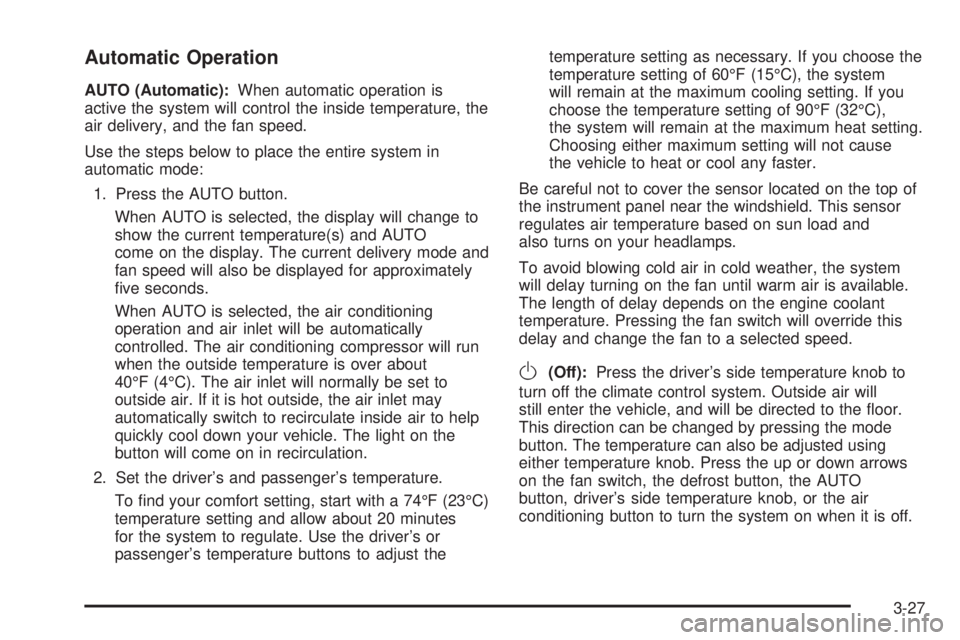
Automatic Operation AUTO (Automatic): When automatic operation is
active the system will control the inside temperature, the
air delivery, and the fan speed.
Use the steps below to place the entire system in
automatic mode:
1. Press the AUTO button.
When AUTO is selected, the display will change to
show the current temperature(s) and AUTO
come on the display. The current delivery mode and
fan speed will also be displayed for approximately
�ve seconds.
When AUTO is selected, the air conditioning
operation and air inlet will be automatically
controlled. The air conditioning compressor will run
when the outside temperature is over about
40°F (4°C). The air inlet will normally be set to
outside air. If it is hot outside, the air inlet may
automatically switch to recirculate inside air to help
quickly cool down your vehicle. The light on the
button will come on in recirculation.
2. Set the driver’s and passenger’s temperature.
To �nd your comfort setting, start with a 74°F (23°C)
temperature setting and allow about 20 minutes
for the system to regulate. Use the driver’s or
passenger’s temperature buttons to adjust the temperature setting as necessary. If you choose the
temperature setting of 60°F (15°C), the system
will remain at the maximum cooling setting. If you
choose the temperature setting of 90°F (32°C),
the system will remain at the maximum heat setting.
Choosing either maximum setting will not cause
the vehicle to heat or cool any faster.
Be careful not to cover the sensor located on the top of
the instrument panel near the windshield. This sensor
regulates air temperature based on sun load and
also turns on your headlamps.
To avoid blowing cold air in cold weather, the system
will delay turning on the fan until warm air is available.
The length of delay depends on the engine coolant
temperature. Pressing the fan switch will override this
delay and change the fan to a selected speed.
O (Off): Press the driver’s side temperature knob to
turn off the climate control system. Outside air will
still enter the vehicle, and will be directed to the �oor.
This direction can be changed by pressing the mode
button. The temperature can also be adjusted using
either temperature knob. Press the up or down arrows
on the fan switch, the defrost button, the AUTO
button, driver’s side temperature knob, or the air
conditioning button to turn the system on when it is off.
3-27
Page 193 of 500
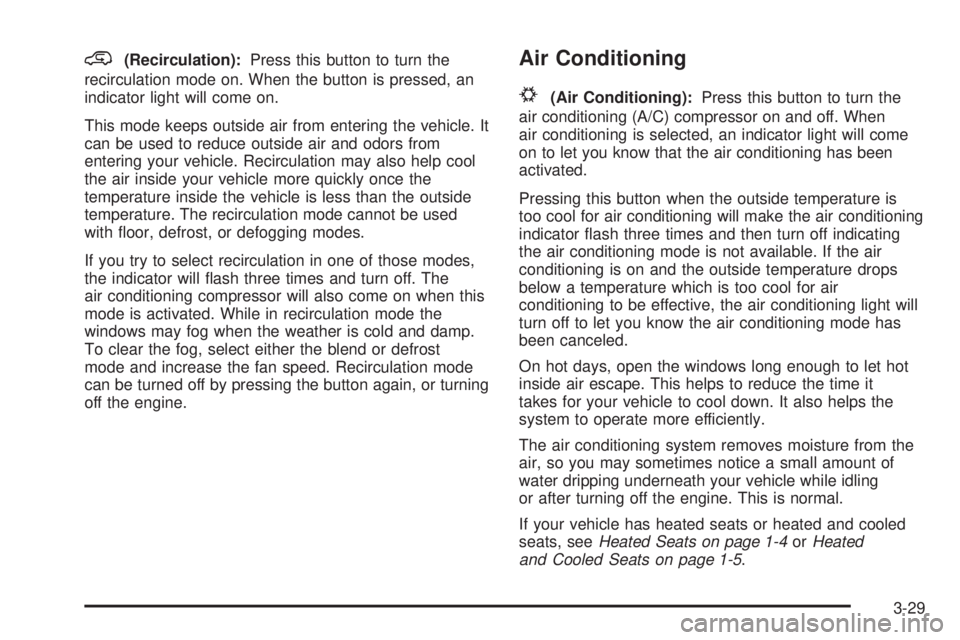
@ (Recirculation): Press this button to turn the
recirculation mode on. When the button is pressed, an
indicator light will come on.
This mode keeps outside air from entering the vehicle. It
can be used to reduce outside air and odors from
entering your vehicle. Recirculation may also help cool
the air inside your vehicle more quickly once the
temperature inside the vehicle is less than the outside
temperature. The recirculation mode cannot be used
with �oor, defrost, or defogging modes.
If you try to select recirculation in one of those modes,
the indicator will �ash three times and turn off. The
air conditioning compressor will also come on when this
mode is activated. While in recirculation mode the
windows may fog when the weather is cold and damp.
To clear the fog, select either the blend or defrost
mode and increase the fan speed. Recirculation mode
can be turned off by pressing the button again, or turning
off the engine. Air Conditioning
# (Air Conditioning): Press this button to turn the
air conditioning (A/C) compressor on and off. When
air conditioning is selected, an indicator light will come
on to let you know that the air conditioning has been
activated.
Pressing this button when the outside temperature is
too cool for air conditioning will make the air conditioning
indicator �ash three times and then turn off indicating
the air conditioning mode is not available. If the air
conditioning is on and the outside temperature drops
below a temperature which is too cool for air
conditioning to be effective, the air conditioning light will
turn off to let you know the air conditioning mode has
been canceled.
On hot days, open the windows long enough to let hot
inside air escape. This helps to reduce the time it
takes for your vehicle to cool down. It also helps the
system to operate more efficiently.
The air conditioning system removes moisture from the
air, so you may sometimes notice a small amount of
water dripping underneath your vehicle while idling
or after turning off the engine. This is normal.
If your vehicle has heated seats or heated and cooled
seats, see Heated Seats on page 1-4 or Heated
and Cooled Seats on page 1-5 .
3-29
Page 194 of 500
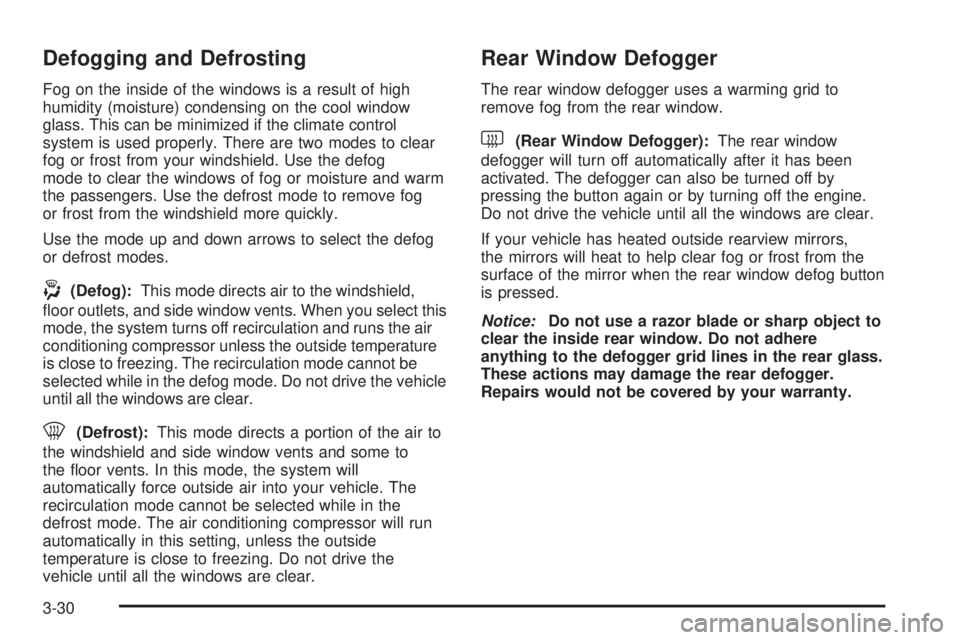
Defogging and Defrosting Fog on the inside of the windows is a result of high
humidity (moisture) condensing on the cool window
glass. This can be minimized if the climate control
system is used properly. There are two modes to clear
fog or frost from your windshield. Use the defog
mode to clear the windows of fog or moisture and warm
the passengers. Use the defrost mode to remove fog
or frost from the windshield more quickly.
Use the mode up and down arrows to select the defog
or defrost modes.
- (Defog): This mode directs air to the windshield,
�oor outlets, and side window vents. When you select this
mode, the system turns off recirculation and runs the air
conditioning compressor unless the outside temperature
is close to freezing. The recirculation mode cannot be
selected while in the defog mode. Do not drive the vehicle
until all the windows are clear.
0 (Defrost): This mode directs a portion of the air to
the windshield and side window vents and some to
the �oor vents. In this mode, the system will
automatically force outside air into your vehicle. The
recirculation mode cannot be selected while in the
defrost mode. The air conditioning compressor will run
automatically in this setting, unless the outside
temperature is close to freezing. Do not drive the
vehicle until all the windows are clear. Rear Window Defogger The rear window defogger uses a warming grid to
remove fog from the rear window.
< (Rear Window Defogger): The rear window
defogger will turn off automatically after it has been
activated. The defogger can also be turned off by
pressing the button again or by turning off the engine.
Do not drive the vehicle until all the windows are clear.
If your vehicle has heated outside rearview mirrors,
the mirrors will heat to help clear fog or frost from the
surface of the mirror when the rear window defog button
is pressed.
Notice: Do not use a razor blade or sharp object to
clear the inside rear window. Do not adhere
anything to the defogger grid lines in the rear glass.
These actions may damage the rear defogger.
Repairs would not be covered by your warranty.
3-30
Page 197 of 500
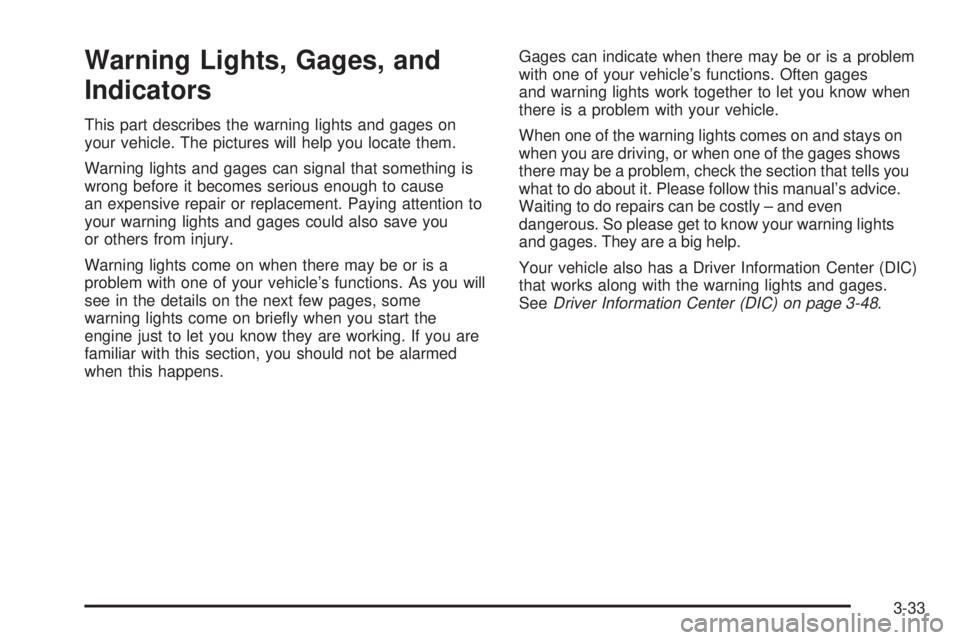
Warning Lights, Gages, and
Indicators This part describes the warning lights and gages on
your vehicle. The pictures will help you locate them.
Warning lights and gages can signal that something is
wrong before it becomes serious enough to cause
an expensive repair or replacement. Paying attention to
your warning lights and gages could also save you
or others from injury.
Warning lights come on when there may be or is a
problem with one of your vehicle’s functions. As you will
see in the details on the next few pages, some
warning lights come on brie�y when you start the
engine just to let you know they are working. If you are
familiar with this section, you should not be alarmed
when this happens. Gages can indicate when there may be or is a problem
with one of your vehicle’s functions. Often gages
and warning lights work together to let you know when
there is a problem with your vehicle.
When one of the warning lights comes on and stays on
when you are driving, or when one of the gages shows
there may be a problem, check the section that tells you
what to do about it. Please follow this manual’s advice.
Waiting to do repairs can be costly – and even
dangerous. So please get to know your warning lights
and gages. They are a big help.
Your vehicle also has a Driver Information Center (DIC)
that works along with the warning lights and gages.
See Driver Information Center (DIC) on page 3-48 .
3-33
Page 199 of 500
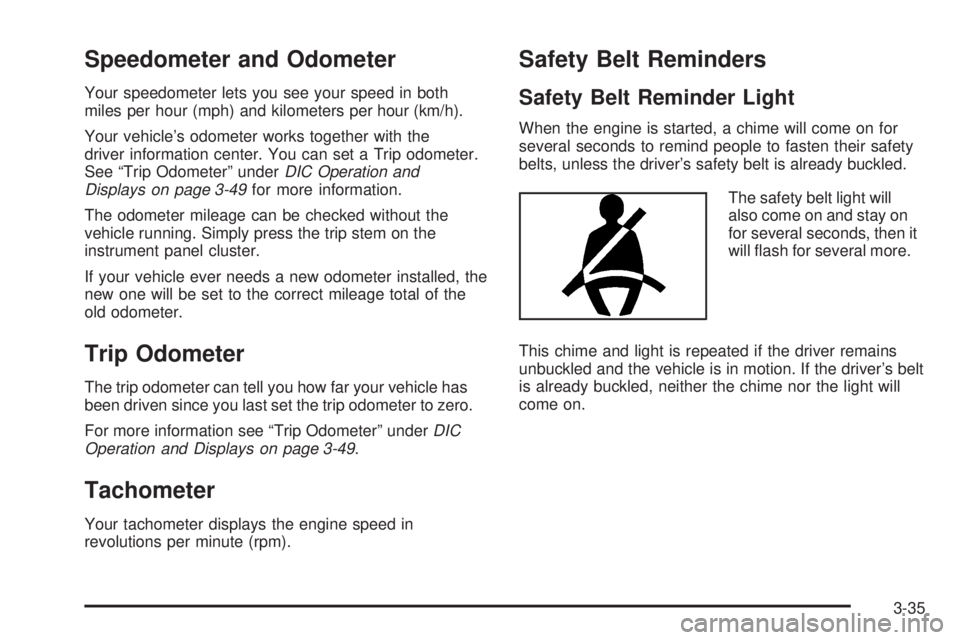
Speedometer and Odometer Your speedometer lets you see your speed in both
miles per hour (mph) and kilometers per hour (km/h).
Your vehicle’s odometer works together with the
driver information center. You can set a Trip odometer.
See “Trip Odometer” under DIC Operation and
Displays on page 3-49 for more information.
The odometer mileage can be checked without the
vehicle running. Simply press the trip stem on the
instrument panel cluster.
If your vehicle ever needs a new odometer installed, the
new one will be set to the correct mileage total of the
old odometer.
Trip Odometer The trip odometer can tell you how far your vehicle has
been driven since you last set the trip odometer to zero.
For more information see “Trip Odometer” under DIC
Operation and Displays on page 3-49 .
Tachometer Your tachometer displays the engine speed in
revolutions per minute (rpm). Safety Belt Reminders Safety Belt Reminder Light When the engine is started, a chime will come on for
several seconds to remind people to fasten their safety
belts, unless the driver’s safety belt is already buckled.
The safety belt light will
also come on and stay on
for several seconds, then it
will �ash for several more.
This chime and light is repeated if the driver remains
unbuckled and the vehicle is in motion. If the driver’s belt
is already buckled, neither the chime nor the light will
come on.
3-35
Page 200 of 500
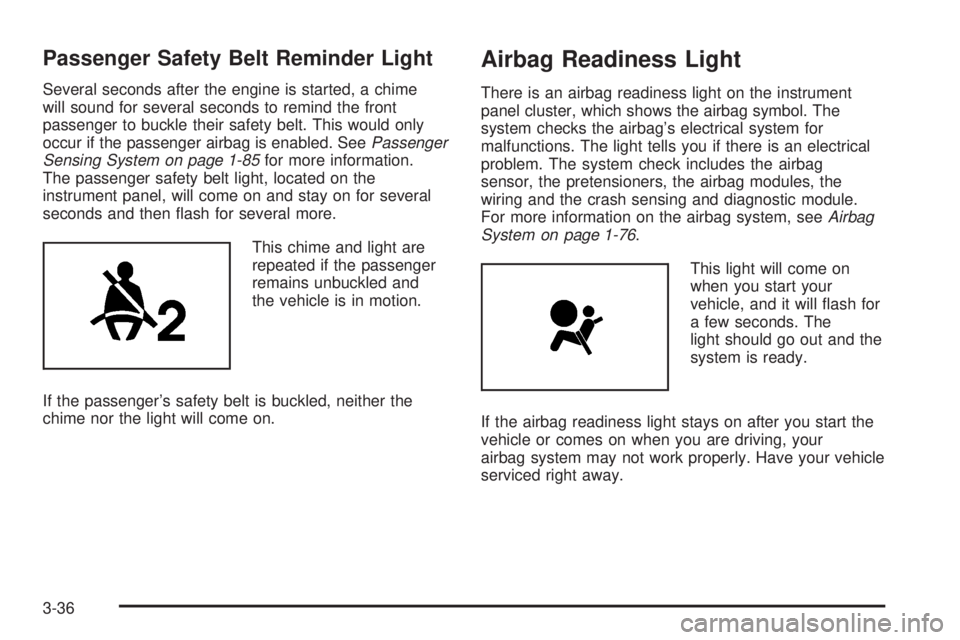
Passenger Safety Belt Reminder Light Several seconds after the engine is started, a chime
will sound for several seconds to remind the front
passenger to buckle their safety belt. This would only
occur if the passenger airbag is enabled. See Passenger
Sensing System on page 1-85 for more information.
The passenger safety belt light, located on the
instrument panel, will come on and stay on for several
seconds and then �ash for several more.
This chime and light are
repeated if the passenger
remains unbuckled and
the vehicle is in motion.
If the passenger’s safety belt is buckled, neither the
chime nor the light will come on. Airbag Readiness Light There is an airbag readiness light on the instrument
panel cluster, which shows the airbag symbol. The
system checks the airbag’s electrical system for
malfunctions. The light tells you if there is an electrical
problem. The system check includes the airbag
sensor, the pretensioners, the airbag modules, the
wiring and the crash sensing and diagnostic module.
For more information on the airbag system, see Airbag
System on page 1-76 .
This light will come on
when you start your
vehicle, and it will �ash for
a few seconds. The
light should go out and the
system is ready.
If the airbag readiness light stays on after you start the
vehicle or comes on when you are driving, your
airbag system may not work properly. Have your vehicle
serviced right away.
3-36
Page 201 of 500
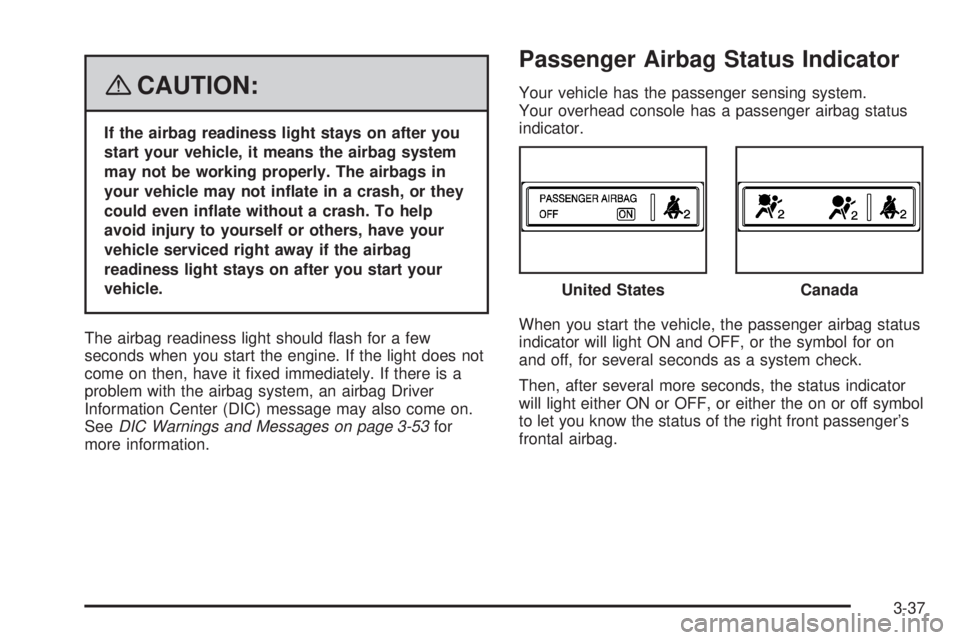
{ CAUTION: If the airbag readiness light stays on after you
start your vehicle, it means the airbag system
may not be working properly. The airbags in
your vehicle may not in�ate in a crash, or they
could even in�ate without a crash. To help
avoid injury to yourself or others, have your
vehicle serviced right away if the airbag
readiness light stays on after you start your
vehicle.
The airbag readiness light should �ash for a few
seconds when you start the engine. If the light does not
come on then, have it �xed immediately. If there is a
problem with the airbag system, an airbag Driver
Information Center (DIC) message may also come on.
See DIC Warnings and Messages on page 3-53 for
more information. Passenger Airbag Status Indicator Your vehicle has the passenger sensing system.
Your overhead console has a passenger airbag status
indicator.
When you start the vehicle, the passenger airbag status
indicator will light ON and OFF, or the symbol for on
and off, for several seconds as a system check.
Then, after several more seconds, the status indicator
will light either ON or OFF, or either the on or off symbol
to let you know the status of the right front passenger’s
frontal airbag. United States
Canada
3-37
Page 203 of 500
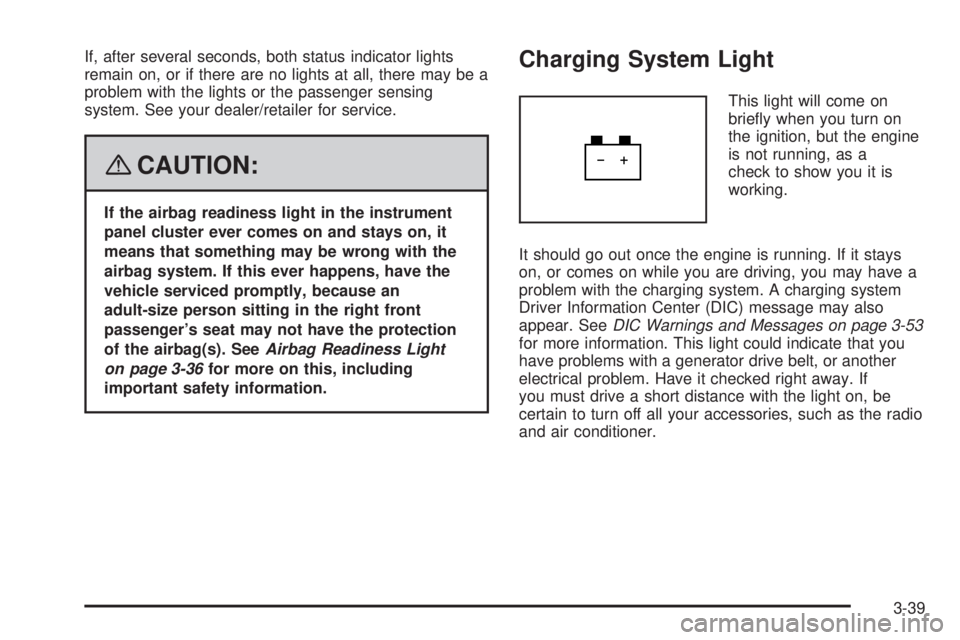
If, after several seconds, both status indicator lights
remain on, or if there are no lights at all, there may be a
problem with the lights or the passenger sensing
system. See your dealer/retailer for service.
{ CAUTION: If the airbag readiness light in the instrument
panel cluster ever comes on and stays on, it
means that something may be wrong with the
airbag system. If this ever happens, have the
vehicle serviced promptly, because an
adult-size person sitting in the right front
passenger’s seat may not have the protection
of the airbag(s). See Airbag Readiness Light
on page 3-36 for more on this, including
important safety information. Charging System Light This light will come on
brie�y when you turn on
the ignition, but the engine
is not running, as a
check to show you it is
working.
It should go out once the engine is running. If it stays
on, or comes on while you are driving, you may have a
problem with the charging system. A charging system
Driver Information Center (DIC) message may also
appear. See DIC Warnings and Messages on page 3-53
for more information. This light could indicate that you
have problems with a generator drive belt, or another
electrical problem. Have it checked right away. If
you must drive a short distance with the light on, be
certain to turn off all your accessories, such as the radio
and air conditioner.
3-39